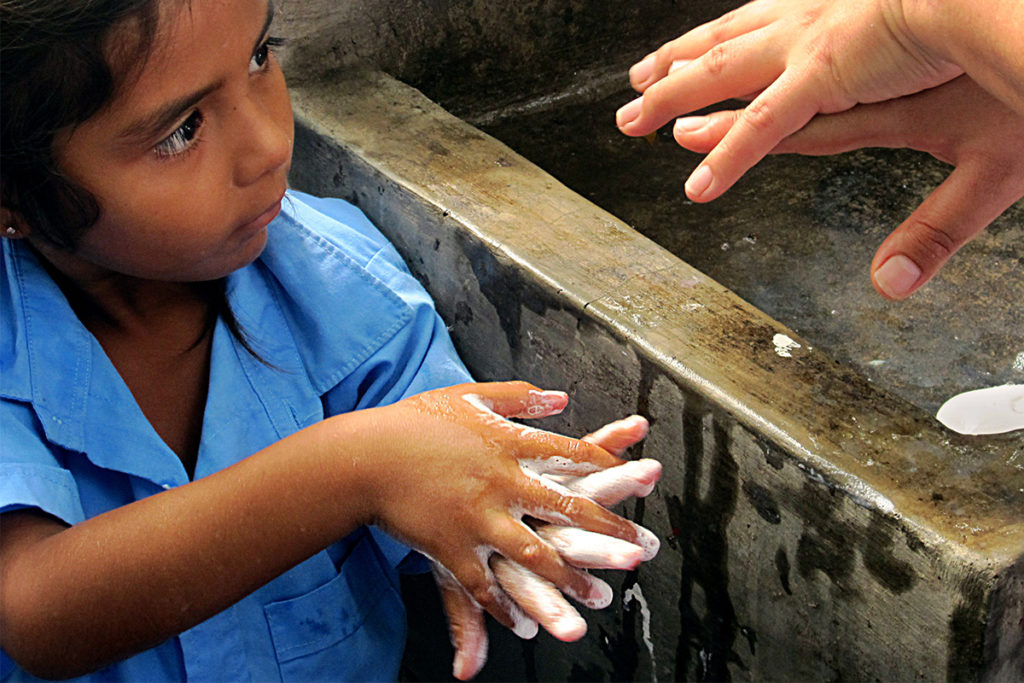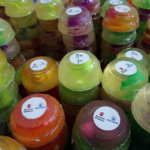The Global Handwashing Partnership has published our annual 2018 Handwashing Research Index, which compiles 155 peer-reviewed journal articles on handwashing research conducted in 53 countries. Our index (a catalog, not a score card) includes searchable tags, links to articles, and the ability to search by title or author. In this post, I describe our process for identifying the 2018 published research and highlight new evidence across three prominent themes: community settings, educational settings, and hand hygiene in health facilities.
Our methodology
We searched the NCBI databases to identify peer-reviewed articles for inclusion in our 2018 index. We first filtered articles with publication dates between December 1, 2017, and December 31, 2018, using keywords in titles and relevant subject terms, including: handwashing, hand hygiene, hand disinfection, and low- and middle-income countries. We included the month of December 2017 to capture articles not represented in the 2017 Handwashing Research Summary due to publication timelines.
Our search initially returned 3,751 studies. We further filtered our results by including only research on handwashing – in isolation, or in integration with other areas, such as sanitation, water quality, maternal and child health, urban design and neglected tropical diseases. We performed this secondary filtering manually and used bibliography and spreadsheet software. Members of the Global Handwashing Partnership Secretariat reviewed the final list of studies for accuracy and screened for errors. Our search placed no limitations on languages, and as a result, there are articles in Chinese, Korean, Portuguese, Spanish and several other languages in the 2018 index.
Handwashing research in community settings
Here are six micro-summaries of articles I find interesting.
Matilla et al. (2018) conducted a systematic review to examine how contact between animals and humans within a household can influence the effectiveness of WASH programs. The researchers present the paucity of returned articles (only two studies out of 7,588 met their inclusion criteria) as a call for greater collaboration between WASH and zoonosis academia.
Under the subtheme of handwashing and urban design, Neves-Silva et al. (2018) conducted a qualitative study in Brazil to examine how limited access to WASH infrastructure violates the human rights to water and sanitation of homeless people in Minas Gerais, Brazil. The authors note this violation of human rights to water and sanitation as a basis for greater municipal involvement to modify social determinants and promote equity.
Subramanian et al. (2018) measured urban housing characteristics, WASH infrastructure and other predictors of preventable water-borne illnesses in Uzbekistan as part of a journal series on environmental health equity. Their findings conclude that social demography, improved housing and social behavior – not only the provision of drinking water and sanitation – are critical in interventions to reduce water-borne diseases.
Kundu et al. (2018) underscore the role of unclean hands in the contamination of stored drinking water and the increased incidence of diarrheal illnesses in semi-urban areas of India. Their study evaluated behavioral and environmental factors connected to the recontamination of stored drinking water after collection and before consumption.
In Guatemala, Kuper et al. (2018) analyzed reporting on WASH access at the household and individual levels. The researchers find individual differences in the levels of access for people with disabilities within their households, such as a need for help with bathing and difficulty in accessing soap without help from others. A multi-country study in Bangladesh, Cameroon, India and Malawi by Mactaggart et al. (2018) also confirms that people with disabilities may have limits on WASH access within the household. Both articles recommend further work to explore context-specific factors.
Brewis et al. (2018) present evidence from Fiji, Guatemala, New Zealand and the United States that closely examines the social toll of disgust-based WASH programming on community members who practice undesired behaviors. Using comparative analysis, the study finds men and women alike appear vulnerable to the negative labels of hygiene norms violations, and to the resulting stigma, contempt and shame. Stigma is most commonly associated with a perception of moral failure, rather than with concerns of the spread of disease.
Handwashing research in educational settings
Here are two micro-summaries of articles with interesting methodologies and findings.
Working in three districts in Indonesia with the highest national prevalence of diarrhea, Arbianingsih et al. (2018) measured the impact of a mobile application on handwashing self-efficacy in preschool children. The application, Arbi Care, is a game that delivers healthy lifestyle education. The control group received standard health behavior education delivered by the school, and the test group received this education from Arbi Care. With the finding that the test group presented higher levels of self-efficacy, the researchers recommend further research on the applications of video game learning for health behavior.
In restrooms at a university in South Korea, Choi et al. (2018) compared the effects of prompts versus feedback on handwashing behavior. Although previous studies have shown that both prompts and feedback are effective in promoting handwashing, the relative efficacy of both mechanisms had not been evaluated. Choi et al. find that in both men and women, feedback – which included signs stating the percentage of restroom users washing hands with soap after restroom use – was more effective than prompts, which included signs encouraging restroom users to wash hands to prevent disease.
Hand hygiene research in health facilities
Here are three micro-summaries of articles I find interesting.
Mannan Laskar et al. (2018) worked with multiple cadres of health workers in two Intensive Care Units of a tertiary care hospital in India to assess the effect of multimodal interventions on hand hygiene compliance at critical times. Conducted over a two-month period, the researchers find that hand hygiene adherence rates were higher during the day than at night with differences in compliance adherence rates between senior and junior physicians. Mannan Laskar et al. propose that the diurnal difference is linked to a lack of proper supervision and routine hand hygiene compliance audits during night shifts, while the compliance difference between senior and junior physicians is linked to a proportional relationship between high patient caseloads for junior physicians and reduced hand hygiene compliance.
Rajasingham et al. (2018) measured water treatment and handwashing practices in a random sample of health facilities in rural Kenya – six years after an initial intervention provided handwashing and drinking water stations – as well as hygiene education for health workers and clients. Although most of the facilities had handwashing and water stations still present and most clients demonstrated appropriate handwashing techniques, most clinics had untreated water. In addition, Rajasingham et al. find that most health facilities had a higher availability of handwashing than drinking water stations but lacked adequate supplies – such as soap – to ensure proper hand hygiene. The authors propose further research to understand how the prioritization of handwashing over drinking water stations occurred.
In Australia, Erichsen Andersson et al. (2018) sampled the operating department of a university hospital to evaluate the process of implementing a knowledge translation program to improve hand hygiene and asepsis in the operating room. Doubts on the efficacy of hand hygiene in preventing hospital acquired infections, and boundaries between health worker cadres were identified as the strongest barriers towards change. The researchers decided to employ organizational learning and person-centeredness in the subsequent intervention.
Conclusion
You can view the list of all 155 studies in the 2018 Handwashing Research Index. If you are interested in more resource tools and updates, visit our Resources Hub and make submissions following our guidelines.
Do you have a question about handwashing research or best practices? Are you interested in unexplored areas of handwashing research? Our Ask the GHP series offers the expertise of the Global Handwashing Partnership. Write to us at contact@globalhandwashing.org.
Photo caption: In Guarjila, El Salvador, a health promoter with Clinica Ana Manganaro shows a primary school student how to properly wash her hands following a dengue fever outbreak in the area.
Photo credit: © 2012 GlobeMed at The University of Texas, Courtesy of Photoshare



